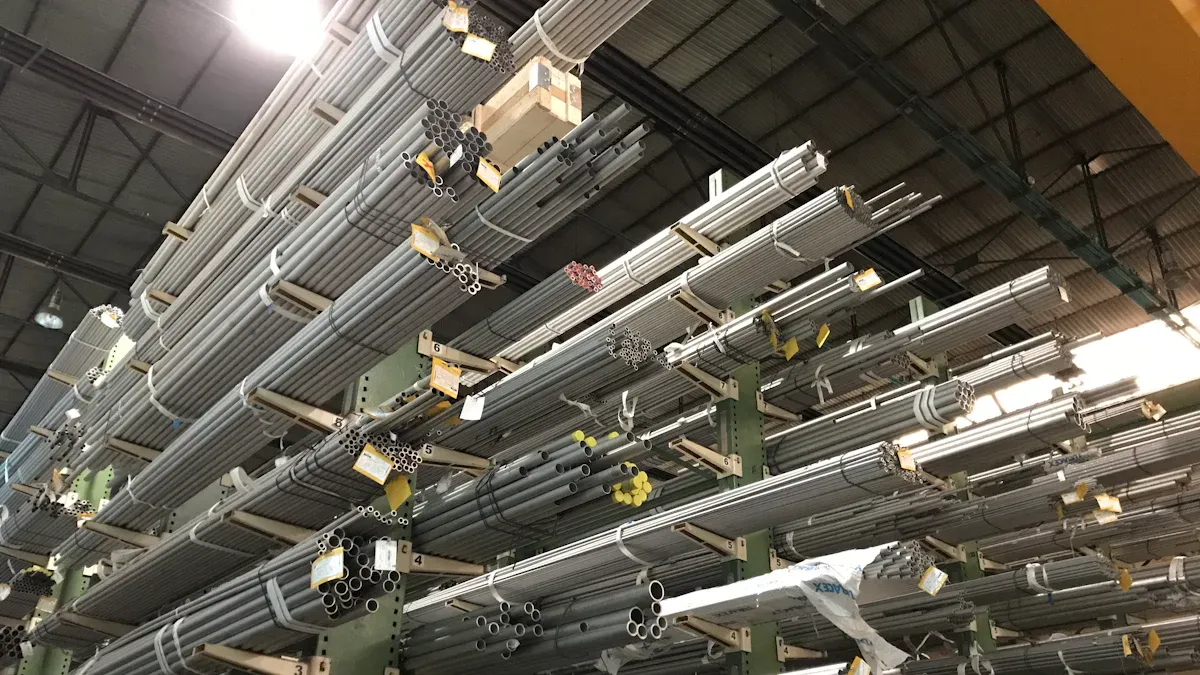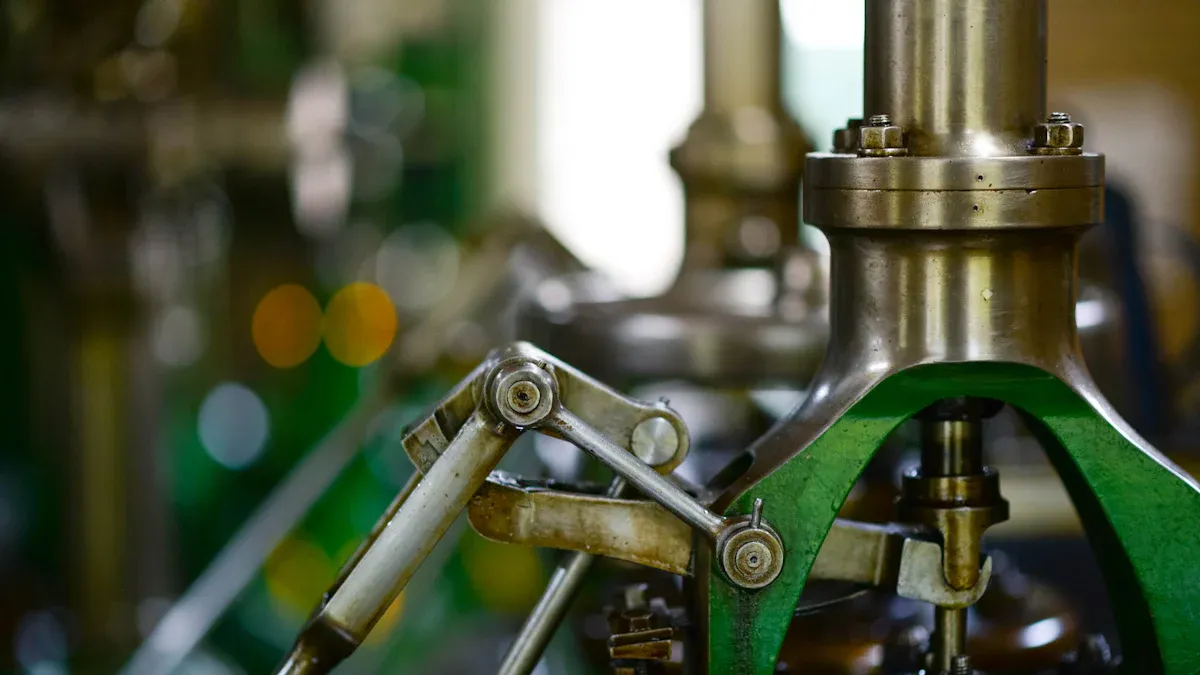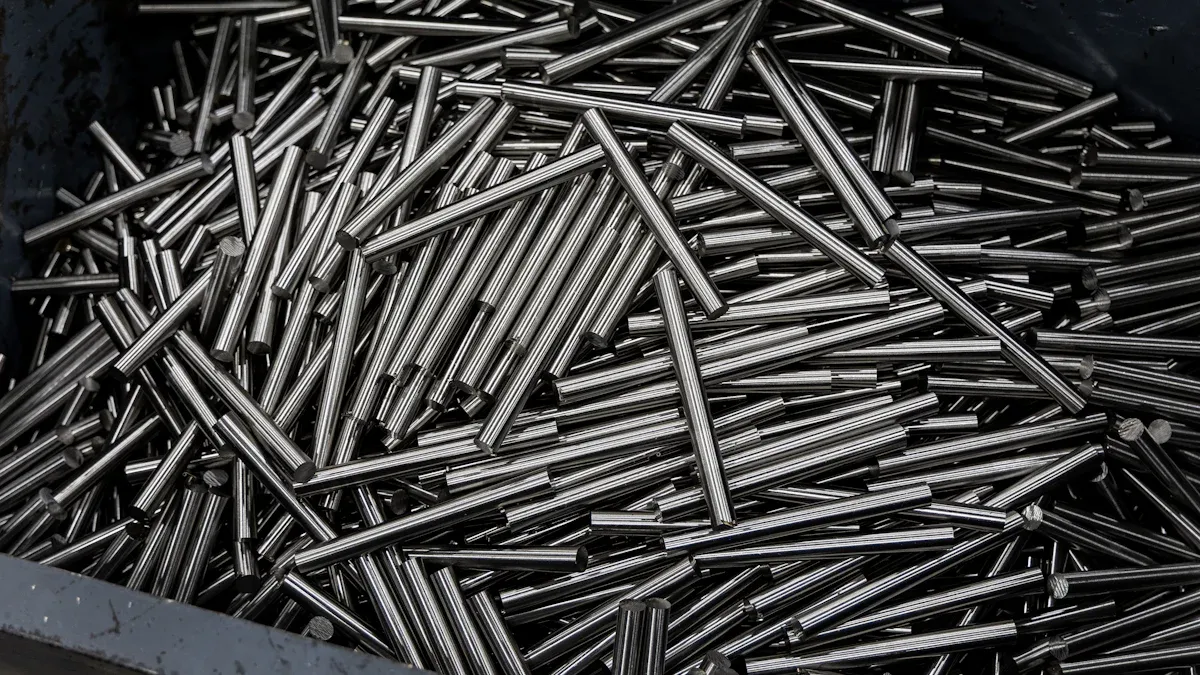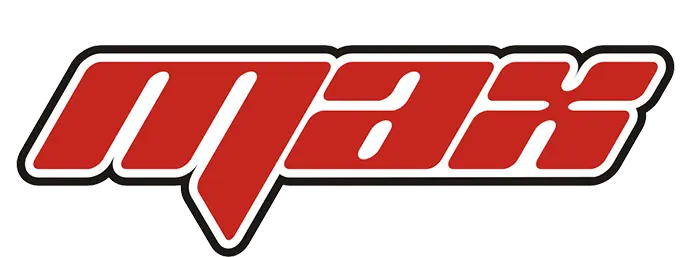
A hard chrome plated rod is an essential component in industrial machinery, engineered to optimize performance under rigorous conditions. The hard chrome plating process forms a durable surface with enhanced hardness, enabling the rod to withstand substantial stress. This method also delivers exceptional wear resistance, minimizing friction and prolonging the operational life of machinery.
These rods are crucial in industries such as construction, mining, and automotive. The application of hard chrome plating greatly enhances performance by reducing friction between moving parts. Additionally, it improves corrosion resistance, particularly in challenging environments like marine and chemical processing. These advantages result in reduced maintenance costs and increased equipment longevity, ensuring maximum efficiency.
Materials Used in Hard Chrome Plated Rods
Common Base Materials for Hard Chrome Plated Rods
Hard chrome plated rods rely on robust base materials to deliver exceptional performance in industrial applications. These materials must withstand high stress, resist wear, and maintain structural integrity under challenging conditions. Commonly used base materials include:
- Steel
- Cast iron
- Stainless steel
- Bronze
- Brass
- Copper
Steel is the most widely used due to its versatility and strength. Stainless steel offers excellent corrosion resistance, making it ideal for marine and chemical environments. Bronze and brass provide good machinability and are often used in specialized applications. Copper, though less common, is chosen for its electrical conductivity in certain industries.
Properties of Medium Carbon Steel and Alloy Steel
Medium carbon steel and alloy steel are popular choices for hard chrome plated rods because of their unique properties. Medium carbon steel provides a balance between strength and ductility, making it suitable for applications requiring durability without brittleness. Alloy steel, on the other hand, incorporates elements like chromium, nickel, and molybdenum to enhance its mechanical properties.
These steels undergo a dual-treatment process, combining induction hardening and chrome plating. Induction-hardened chrome rods exhibit superior surface hardness, ensuring they resist wear and fatigue. This dual-treatment process also improves the rod’s ability to handle heavy loads and repetitive motion, making it indispensable in industries like construction and manufacturing.
Environmental Suitability of Base Materials
Selecting the right base material depends on the operating environment. For corrosive settings, stainless steel and bronze are excellent choices due to their resistance to rust and chemical damage. In high-temperature environments, alloy steel performs well because of its thermal stability. Medium carbon steel is ideal for general-purpose applications where cost-effectiveness and strength are priorities.
The plating process further enhances environmental suitability. Hard chrome plating creates a protective layer that shields the base material from moisture, chemicals, and abrasive forces. This layer ensures the rod maintains its integrity even in harsh conditions, such as marine or hydraulic systems.
To illustrate the technical aspects of material selection, consider the following data:
| Parameter | Value |
|---|---|
| Current Density | 4.0 APSI for 100 in² surface |
| Maximum Plating Rate | 4 to 5 APSI at 140 to 145°F |
| Chromium Deposition Rate | 0.50 to 0.75 mils/hour (stick anodes) |
| 1.0 to 1.5 mils/hour (conforming anodes) |
This data highlights the precision required in the plating process to achieve optimal performance. By understanding these parameters, you can make informed decisions when selecting hard chrome plated rods for your specific needs.
Strength and Durability of Hard Chrome Plated Rods

Hard Chrome Plating and Increased Hardness
Hard chrome plating significantly enhances the hardness of industrial rods, making them ideal for demanding applications. This process creates a dense, uniform layer that resists deformation under heavy loads. You can rely on this increased hardness to maintain the structural integrity of machinery components, even in high-pressure environments.
Laboratory measurements confirm the remarkable hardness achieved through hard chrome plating. The following table highlights the results of various testing methods:
| Measurement Method | Minimum Thickness Required | Hardness Level |
|---|---|---|
| Rockwell 15N | 0.006 in. | 60 HRC and above |
| Direct Rockwell C | 0.022 in. | 69 HRC and above |
| Knoop Microhardness | 0.001 in. | Varies |
These results demonstrate how hard chrome plating ensures consistent performance by delivering exceptional hardness across different thickness levels.
Unmatched Wear Resistance and Fatigue Strength
Hard chrome plating provides unmatched wear resistance, which is crucial for components exposed to repetitive motion and friction. This extreme wear resistance minimizes surface degradation, allowing machinery to operate smoothly over extended periods. Additionally, the plating reduces low friction between moving parts, further enhancing durability.
The fatigue strength of hard chrome plated rods is another key advantage. By resisting surface cracks and material fatigue, these rods maintain their functionality under cyclic loading. This superior fatigue strength ensures that your equipment performs reliably, even in the most demanding conditions.
Corrosion Protection in Challenging Environments
Hard chrome plating offers exceptional corrosion protection, making it a preferred choice for harsh environments. The plating acts as a barrier, shielding the base material from moisture, chemicals, and other corrosive elements. This corrosion-resistant plating is especially valuable in marine, chemical, and hydraulic systems.
Tests like the salt spray chamber evaluation confirm the effectiveness of hard chrome plating in resisting corrosion. These tests simulate aggressive environments, such as coastal atmospheres, to predict long-term performance. They also help identify microscopic defects, ensuring additional protective measures are implemented during the plating process.
By choosing hard chrome plated rods, you gain reliable corrosion resistance and long-lasting protection for your equipment, even in the toughest conditions.
Applications of Hard Chrome Plated Rods

Use in Construction and Heavy Machinery
Hard chrome plated rods play a vital role in construction and heavy machinery. These rods provide the durability and strength needed to handle demanding tasks. Their corrosion resistance ensures they perform well in harsh environments, such as construction sites exposed to moisture and chemicals. The hard chrome plating acts as a protective barrier, preventing rust and extending the lifespan of components.
The unmatched wear resistance of these rods makes them ideal for hydraulic systems in heavy machinery. The smooth, hard surface minimizes wear caused by repetitive motion, reducing maintenance needs. Additionally, their improved load capacity allows them to handle higher weights without bending or deforming. This enhances the safety and efficiency of equipment like excavators, cranes, and bulldozers.
Manufacturing and Automation Systems
In manufacturing and automation systems, precision and reliability are critical. Hard chrome plated rods excel in these applications due to their ability to maintain consistent performance under high stress. The hard chrome plating ensures a smooth surface finish, reducing friction between moving parts. This improves the efficiency of automated systems and minimizes energy consumption.
These rods are commonly used in hydraulic cylinders, which are essential for controlling motion in automated machinery. The hydraulic cylinder chrome plating provides excellent resistance to wear and corrosion, ensuring long-lasting performance. Whether in robotic arms or conveyor systems, these rods contribute to precision manufacturing by delivering consistent results.
Marine and Hydraulic Applications
Marine environments present unique challenges, including exposure to saltwater and humidity. Hard chrome plated rods are well-suited for these conditions due to their exceptional corrosion resistance. The chrome cylinder plating creates a protective layer that shields the base material from moisture and chemical damage. This makes them indispensable in shipbuilding and offshore drilling equipment.
In hydraulic applications, these rods provide heavy-duty performance by withstanding high pressure and repetitive motion. The hard chrome plating ensures they resist surface degradation, maintaining their functionality over time. Whether in marine hydraulics or industrial systems, these rods deliver reliable performance in demanding environments.
Choosing the Right Hard Chrome Plated Rod
Evaluating Material Grade and Strength
Selecting the right material grade and strength is essential for ensuring the performance and longevity of a hard chrome plated rod. You should begin by assessing the mechanical properties of the base material. Medium carbon steel and alloy steel are excellent choices for general-purpose applications due to their balance of strength and ductility. For environments requiring corrosion resistance, stainless steel offers superior protection against rust and chemical damage.
When evaluating material strength, consider the load-bearing capacity and fatigue resistance of the rod. Hard chrome plating enhances these properties by creating a dense, durable surface layer. This layer minimizes wear and prevents deformation under heavy loads. By choosing the appropriate material grade, you can ensure the rod meets the demands of your specific industrial application.
Determining Optimal Plating Thickness
The thickness of the hard chrome plating plays a critical role in the rod’s performance. You should determine the optimal thickness based on the intended application and operating conditions. For heavy-duty machinery, thicker plating provides better wear resistance and durability. In contrast, thinner plating is suitable for applications requiring precision and minimal friction.
Hard chrome plating typically ranges from 0.0005 to 0.005 inches in thickness. This variation allows you to customize the rod’s properties to match your needs. Laboratory tests confirm that thicker plating enhances hardness and corrosion resistance, while thinner layers improve surface smoothness. By carefully selecting the plating thickness, you can optimize the rod’s performance and extend its lifespan.
Assessing Surface Finish for Specific Applications
Surface finish quality is a crucial factor in determining the suitability of a hard chrome plated rod for specific applications. You should evaluate the surface characteristics using industry standards like ANSI/ASME B46.1. This specification outlines measurement techniques for assessing parameters such as average roughness (Ra) and maximum height profile (Rz). These metrics help quantify the smoothness and consistency of the rod’s surface.
For applications requiring minimal friction, a smoother surface finish is essential. The ANSI/ASME B46.1 standard emphasizes consistent inspection methods to avoid sampling errors, ensuring the rod meets the necessary quality requirements. By adhering to these standards, you can select a rod with the ideal surface finish for your industrial needs.
Tip: A high-quality surface finish not only improves performance but also reduces maintenance costs by minimizing wear and tear on machinery components.
Considering Environmental and Operational Requirements
When selecting a hard chrome plated rod, you must evaluate how environmental and operational factors will influence its performance. These considerations ensure the rod meets your specific needs while maintaining efficiency and durability in challenging conditions.
Environmental Performance Metrics to Evaluate
Understanding the environmental performance of a hard chrome plated rod helps you make informed decisions. The following metrics are critical for assessing how well the rod will perform in various settings:
- Friction Behavior: The friction properties of piston seals and piston rod seals directly impact operational efficiency. Lower friction reduces energy consumption and wear, which benefits both performance and the environment.
- Wear Resistance: Coatings that resist wear maintain their integrity over time, reducing the need for frequent replacements. This minimizes waste and supports sustainable operations.
- Leakage Control: Effective coatings prevent leakage in hydraulic systems, ensuring optimal performance and reducing environmental contamination risks.
- Coating Longevity: Advanced coatings are designed to retain their structure and roughness over time. This ensures consistent performance without compromising environmental standards.
By focusing on these metrics, you can select a rod that aligns with your operational goals and environmental responsibilities.
Matching Rods to Operational Conditions
Operational requirements vary widely across industries. To choose the right rod, you need to consider the specific conditions it will face. For example, in high-pressure hydraulic systems, rods must withstand intense forces without deforming. Hard chrome plating enhances the rod’s surface hardness, ensuring it resists wear and maintains functionality under heavy loads.
In environments with high humidity or chemical exposure, corrosion resistance becomes a top priority. The protective layer created by hard chrome plating shields the rod from rust and chemical damage. This makes it ideal for marine applications or chemical processing plants. For industries requiring precision, such as manufacturing and automation, a smooth surface finish is essential. This reduces friction between moving parts, improving efficiency and extending the lifespan of machinery.
Balancing Performance and Sustainability
You should also consider how the rod’s performance aligns with sustainability goals. Hard chrome plated rods offer a durable solution that reduces the frequency of replacements. This not only lowers operational costs but also minimizes environmental impact. By selecting a rod with advanced coatings, you can achieve high performance while adhering to environmental standards.
Tip: Always consult with experts to ensure the rod you choose meets both your operational needs and environmental requirements. This approach guarantees long-term reliability and sustainability for your equipment.
By carefully evaluating environmental and operational factors, you can select a hard chrome plated rod that delivers exceptional performance while supporting your commitment to sustainability.
Hard chrome plated rods play a vital role in industrial applications by enhancing the performance and durability of machinery. Their ability to withstand heavy loads, resist wear, and combat corrosion ensures reliable operation in even the most demanding environments.
The benefits of hard chrome plating are undeniable. It increases surface hardness, reduces friction, and extends the lifespan of components. Studies show that chrome formulations can improve mold performance by up to 4400% compared to unplated materials. This remarkable durability translates into significant cost savings and operational efficiency for industries worldwide.
When selecting a rod, you should carefully evaluate your specific requirements. Consider factors like material grade, plating thickness, and environmental conditions. Consulting with experts ensures you choose a solution tailored to your needs, maximizing both performance and value.
Tip: Investing in high-quality hard chrome plated rods not only boosts equipment longevity but also reduces maintenance costs, making it a smart choice for sustainable operations.
FAQ
What is the typical lifespan of a hard chrome plated rod?
The lifespan depends on the application and operating conditions. In general, hard chrome plated rods last several years due to their exceptional wear resistance and corrosion protection. Regular maintenance and proper usage can further extend their durability.
How do you maintain hard chrome plated rods?
You should clean the rods regularly to remove dirt and debris. Inspect for signs of wear or corrosion. Use appropriate lubricants to reduce friction and prevent surface damage. Avoid exposing the rods to extreme conditions beyond their design limits.
Can hard chrome plated rods be repaired if damaged?
Yes, you can repair damaged rods through re-plating or grinding processes. These methods restore the surface finish and protective layer. Consult a professional to assess the damage and determine the best repair solution for your specific application.
Are hard chrome plated rods environmentally friendly?
Hard chrome plated rods are durable, reducing the need for frequent replacements. This minimizes waste and supports sustainability. However, the plating process involves chemicals, so you should choose suppliers who follow environmentally responsible practices.
What industries benefit the most from hard chrome plated rods?
Industries like construction, manufacturing, marine, and automotive benefit greatly. These rods enhance machinery performance by providing wear resistance, corrosion protection, and durability. They are especially valuable in hydraulic systems, heavy machinery, and environments with high stress or moisture exposure.
